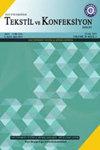An experimental design approach to examine the influencing parameters of poly(butylene succinate) (PBS) nanofibrous nonwoven by solution blow spinning
IF 0.7
4区 工程技术
Q4 MATERIALS SCIENCE, TEXTILES
引用次数: 0
Abstract
Green polymers have gained popularity in recent decades because of the rising pollution in the world. Poly(butylene succinate) (PBS) is an aliphatic polyester and a relatively new polymer. PBS is regarded as one of the most promising materials for various applications due to its exceptional processability and regulated biodegradability and attracts the attention of many researchers. The application fields of its products when combined with the solution blow spinning (SBS) method, may be expanded to textiles, food, packaging, filters, batteries, and biomedical due to its outstanding biodegradability, processability, and thermal and chemical resistance. Therefore, this study focused on the SBS process as a PBS polymer solution to scale up the nanofibers manufacturing process to the commercial level. In this research, PBS nonwovens were produced by an SBS apparatus. The effects of spinning parameters (solution concentration, air pressure, and flow rate) on the average fiber diameter were studied. The PBS solution blown nonwovens was characterized by scanning electron microscopy. A software was used to measure fiber diameter and distribution. PBS nonwovens were mostly on a nanometer scale with the presence of a few defects. A full factorial design was used to the test data for statistical analysis to investigate how solution concentration, air pressure, and flow rate influenced average fiber diameter. The impact of process control factors is examined using analysis of variance. Results have shown that solution concentration significantly influenced of mean diameter. The fast and economic feature of the SBS process, as well as the environmentally friendly nature of the PBS polymer, may considerably contribute to the industrial-scale manufacturing of nanofibrous nonwoven made from this polymer.采用实验设计方法研究了溶液吹丝法制备聚琥珀酸丁二烯纳米纤维非织造布的影响因素
近几十年来,由于全球污染的加剧,绿色聚合物越来越受欢迎。聚丁二酸丁二醇酯(PBS)是一种脂肪族聚酯,也是一种相对较新的聚合物。PBS由于其优异的可加工性和可调节的生物降解性而被认为是最有前途的各种应用材料之一,并引起了许多研究人员的注意。其产品与溶液吹塑(SBS)法相结合,由于其优异的生物降解性、可加工性、耐热性和耐化学性,其应用领域可能扩展到纺织品、食品、包装、过滤器、电池和生物医学。因此,本研究将SBS工艺作为PBS聚合物溶液,将纳米纤维制造工艺扩大到商业水平。在本研究中,采用SBS装置生产PBS非织造布。研究了纺丝参数(溶液浓度、气压和流速)对纤维平均直径的影响。用扫描电子显微镜对PBS溶液吹制非织造布进行了表征。使用软件测量纤维直径和分布。PBS非织造布大多是纳米级的,存在一些缺陷。使用全因子设计对测试数据进行统计分析,以研究溶液浓度、空气压力和流速如何影响平均纤维直径。使用方差分析来检验过程控制因素的影响。结果表明,溶液浓度对平均直径有显著影响。SBS工艺的快速和经济特征,以及PBS聚合物的环境友好性质,可能大大有助于由该聚合物制成的纳米纤维非织造布的工业规模制造。
本文章由计算机程序翻译,如有差异,请以英文原文为准。
求助全文
约1分钟内获得全文
求助全文
来源期刊

Tekstil Ve Konfeksiyon
工程技术-材料科学:纺织
CiteScore
1.40
自引率
33.30%
发文量
41
审稿时长
>12 weeks
期刊介绍:
Tekstil ve Konfeksiyon, publishes papers on both fundamental and applied research in various branches of apparel and textile technology and allied areas such as production and properties of natural and synthetic fibers, yarns and fabrics, technical textiles, finishing applications, garment technology, analysis, testing, and quality control.
 求助内容:
求助内容: 应助结果提醒方式:
应助结果提醒方式:


